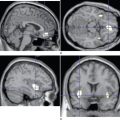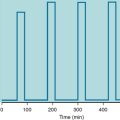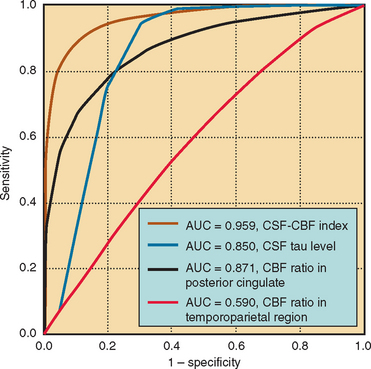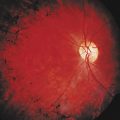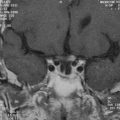CHAPTER 57 TENSION-TYPE HEADACHE
Tension-type headache, the most common of the primary headaches,1,2 has tremendous socioeconomic effects.2,3 For many years, various terms such as tension headache, muscle contraction headache, psychomyogenic headache, stress headache, ordinary headache, essential headache, idiopathic headache, and psychogenic headache were used to characterize this common headache disorder. In 1988, the International Headache Society, to avoid using terminology with a specific pathophysiological implication, introduced the term tension-type headache.4 The pathophysiology of tension-type headache is still far from clear, although advances in basic and clinical research have increased knowledge about the mechanisms underlying this disorder.5,6
DEFINITION
The second edition of The International Classification of Headache Disorders (ICHD-II)7 subdivides tension-type headache into three main forms:
All forms are subdivided further into headache associated or not associated with pericranial tenderness. Diagnostic criteria are shown in Table 57-1.
|
At least 10 episodes occurring on <1 day per month on average (<12 days per year) and fulfilling the next three criteria:
|
EPIDEMIOLOGY
The lifetime prevalence of tension-type headache is between 30% and 78%.1,2 Most affected patients (59%) reported tension-type headache one day each month or less; 24% to 37% had headache several times each month; 10% had it weekly; and 2% to 3% of the population had chronic tension-type headache (≥15 days per month).8 The global prevalence of chronic tension-type headache is uniform (i.e., 2% to 3%). Unlike migraine headache, women are only slightly more affected than men, with a male/female ratio of 4:5.1,2,6
CLINICAL FEATURES
Tension-type headache is diagnosed exclusively on the basis of the history and somatic and neurological examination findings. The infrequent subtype has very little effect on the individual and does not represent a clinical or treatment challenge. However, frequent and chronic subtypes are always associated with considerable disability and high personal and socioeconomic costs. Patients usually complain of mild to moderate pain of varying duration in both the infrequent and frequent episodic forms of tension-type headache or of constant mild or moderate pain in the chronic form. The headache is bilateral, pressing or tightening pain, often described as feeling like “a pressure bandage around the head.” It is never associated with typical migrainous characteristics, such as aggravation by routine physical activity, severe nausea, vomiting, and severe photophobia or phonophobia. According to the ICHD-II criteria (see Table 57-1), patients with infrequent and frequent episodic tension-type headache have no more than one of the associated symptoms of photophobia or phonophobia. Mild nausea, photophobia, or phonophobia (no more than one of these symptoms) may be present in chronic tension-type headache.
ETIOLOGY AND PATHOPHYSIOLOGY
Although there has been considerable progress in research on tension-type headache,5,6 the origin of pain in this prevalent primary headache is unknown. It has been suggested that both peripheral (nociception from myofascial tissue) and central (increased excitability of central nervous system) factors play a major role in the pathophysiology of tension-type headache. Epidemiological studies reported an increased familial risk in tension-type headache.9,10
Peripheral Factors
Individuals who have been exposed to static or repetitive work for long periods of time may develop pericranial muscle tenderness and tension-type headache. Therefore, for many years the research on the mechanisms that lead to tension-type headache focused on peripheral or muscular factors. Increased pericranial myofascial tissue tenderness to manual palpation is the most prominent abnormal finding in patients with chronic tension-type headache.11–13 Painful impulses from these tissues may be referred to the head and perceived as headache, and myofascial mechanisms may therefore play a major role in the pathophysiology of tension-type headache.14 Possible excessive pericranial muscle contraction, ischemia, and inflammation have been extensively studied in tension-type headache; however, electromyography with surface electrodes failed to demonstrate significantly increased activity.15–17
A microdialysis study reported altered blood flow regulation in tender skeletal muscles of patients with chronic tension-type headache during static work.18 The authors found no difference in locally increased interstitial lactate between patients and control subjects. This seems to rule out the presence of ischemia in the tender points of chronic tension-type headache patients during static exercise. It was hypothesized that increased excitability of neurons in the central nervous system may affect the regulation of muscle blood flow during static work.18 The microdialysis study also demonstrated that the interstitial concentration of inflammatory mediators in tender muscle did not differ between patients with chronic tension-type headache and healthy subjects.19 These data indicate that tender points are not sites of ongoing inflammation.
Central Factors
Since the mid-1990s, there has been increasing interest in the role of central factors in tension-type headache. It has been shown that pressure pain detection and thresholds of tolerance of mechanical stimuli were decreased in chronic tension-type headache sufferers.20,21 Furthermore, Bendtsen and colleagues22 demonstrated that patients with chronic tension-type headache had a qualitatively altered pain perception. On the basis of these findings and data from basic pain research,23 it has been suggested that the central sensitization, and therefore the chronic pain state, in patients with chronic tension-type headache may result from sensitization at the level of the spinal dorsal horn, the trigeminal nucleus, or both, induced by prolonged nociceptive input from pericranial myofascial tissues.6 The hypothesis of central sensitization in tension-type headache is supported by experimental pharmacological studies. Animal studies have shown that sensitization of pain pathways may be caused by or associated with activation of nitric oxide synthase and the generation of nitric oxide.24 To test the hypothesis of central sensitization in tension-type headache, the antinociceptive effect of nitric oxide synthase inhibitors25,26 and the nociceptive effect of nitric oxide donor27 were investigated in patients with chronic tension-type headache. The nitric oxide synthase inhibitor NG-monomethyl-L-arginine hydrochloride reduced headache and pericranial myofascial tenderness and hardness. Furthermore, the nitric oxide donor glyceryl trinitrate induced tension-type headache in these patients.27 These data suggest that nitric oxide plays an important role in the pathophysiology of chronic tension-type headache5 and that inhibition of nitric oxide synthase may become a novel principle in the treatment of this disorder.
Genetics
A single genetic epidemiological study has investigated the familial aggregation of chronic tension-type headache in 122 probands recruited from a headache clinic.9 In comparison with the general population, first-degree relatives of the probands had a 3.1-fold increased risk of chronic tension-type headache, whereas spouses had no increased risk of chronic tension-type headache. It was suggested that an increased familial risk can be caused by both genetic and environmental factors.10
TREATMENT
The current pharmacotherapy of tension-type headache is nonspecific and includes simple analgesics and nonsteroidal anti-inflammatory drugs (NSAIDs) for the episodic form and antidepressants for prophylaxis in the chronic form. Before any pharmacological or nonpharmacological therapy is initiated, an accurate diagnosis must be established. Patients with frequent episodic or chronic tension-type headache should complete a 4-week diagnostic headache diary28 to confirm the diagnosis and to rule out possible medication overuse headache.
Acute Therapy
Acute pharmacotherapy includes treating each episode of tension-type headache (i.e., infrequent and frequent episodic tension-type headache according to ICHD-II criteria). Simple analgesics and NSAIDs are the mainstays of acute tension-type headache therapy (Table 57-2). Aspirin and acetaminophen are the most commonly used analgesics. Randomized, controlled trials have demonstrated that acetaminophen, aspirin, and NSAIDs are effective in the treatment of single episodes of tension-type headache and should be included in the treatment of mild or moderate episodes (for review, see Ashina and Ashina29). Acetaminophen may be the first choice because of a better gastric side effect profile. More randomized, controlled, and comparative studies are needed to evaluate the efficacy and safety of combination analgesics in the treatment of infrequent and frequent episodic tension-type headache.29 Muscle relaxants are not considered effective because of insufficient studies and the risk of habituation30 and generally are not recommended. In addition, physicians should be aware of the risk of developing medication overuse headache as a result of frequent and excessive use of analgesics used in acute therapy. Recommended dosages of simple analgesics are shown in Table 57-2.
TABLE 57-2 Recommended Dosages for Acute and Preventive Therapy of Tension-Type Headache
* For fewer than 15 headache days per month. Drugs used in acute therapy are classified hierarchically according to efficacy demonstrated in placebo-controlled trials. Dosages in preventive therapy are increased until efficacy or side effects are reported.
Modified from Ashina S, Ashina M: Current and potential future drug therapies for tension-type headache. Curr Pain Headache Rep 2003; 7:466-474, with permission from BioMed Central.
Preventive Therapy
Preventive treatment is considered if a patient experiences a headache on 15 or more days each month (i.e., chronic tension-type headache). Controlled randomized trials have demonstrated that amitriptyline has a statistically significant and clinically relevant effect in the prophylactic treatment of chronic tension-type headache.31–34 In addition, amitriptyline reduced secondary variables, such as headache duration and frequency, intake of analgesics, and myofascial tenderness.35 Amitriptyline should be considered the drug of first choice in the preventive treatment of chronic tension-type headache (see Table 57-2). Bendtsen and Jensen35 evaluated the efficacy of the noradrenergic and serotonergic antidepressant mirtazapine in 24 nondepressed patients with chronic tension-type headache in a randomized, double-blind, placebo-controlled, crossover trial. Mirtazapine reduced the area-under-the-headache curve (duration × intensity) by 34% more than placebo, and headache frequency, duration, and intensity in patients whose condition was difficult to treat, including patients who had not responded to amitriptyline. Mirtazapine was well tolerated. The efficacy was comparable with that of amitriptyline as reported in a previous study that used the same methods, but there were considerably fewer side effects. Mirtazapine should be considered the drug of second choice for the prophylactic treatment of chronic tension-type headache. In a randomized, double-blind, placebo-controlled, crossover trial, the selective serotonin reuptake inhibitor (SSRI) citalopram had no effect on patients with chronic tension-type headache.31 In a randomized, double-blind, placebo-controlled, crossover trial, tizanidine was more effective than placebo at the end of the treatment period, and the authors suggested that tizanidine was effective in the preventive treatment of chronic tension-type headache in women.36 In another study, however, the effects of a modified-release formulation of tizanidine in dosages up to 12 mg daily did not differ from those of placebo.37 In summary, more placebo-controlled trials are needed to demonstrate the possible efficacy of SSRIs and muscle relaxants in the preventive treatment of chronic tension-type headache.
Data on the efficacy of botulinum toxin in the treatment of tension-type headache are based on a limited number of studies with several methodological reservations.29 No common consensus has been reached on the number of injection sites and dosages in clinical trials. The results demonstrate a need for additional randomized controlled trials with standard procedures before botulinum toxin can be recommended for the preventive treatment of chronic tension-type headache.
Nonpharmacological Therapy
Behavioral approaches and physiotherapy are widely used as adjunct therapies and also, to a lesser extent, as an alternative to standard medication. The main goal of these approaches is to eliminate factors that are responsible for an increase in frequency and severity of tension-type headache. The question is whether there is a strong evidence-based effect of nonpharmacological therapy. Few studies have addressed these issues in a controlled design with properly classified patients with tension-type headache. Holroyd and associates38 reported that cognitive-behavioral (stress management) therapy had effectiveness comparable with that of amitriptyline in 41 patients with recurrent tension-type headache. In a large randomized, controlled trial, tricyclic antidepressant medication and stress management therapy each produced larger reductions in headache activity, analgesic medication use, and headache-related disability than did placebo, but antidepressant medication yielded more rapid improvements in headache activity.39 Combined therapy was more likely to produce clinically significant reductions in headache index scores (in 64% of participants) than was antidepressant medication (in 38%), stress management therapy (in 35%), or placebo (in 29%). The authors concluded that combined therapy might improve outcomes in relation to monotherapy.39 Torelli and colleagues40 investigated the therapeutic effect of physiotherapy in 48 patients with frequent episodic tension-type headache or chronic tension-type headache. After a 4-week run-in period, patients were randomly assigned to either an 8-week period of standardized physiotherapy (group 1) or an 8-week observation period followed by an identical course of physiotherapy (group 2). After the physiotherapy, all patients were monitored for a 12-week follow-up period. Although the average number of days with headache per 4-week period was significantly reduced by physiotherapy in comparison with waiting list, severity and duration of headache, as well as drug consumption, did not differ. Interestingly, the number of responders was higher among patients with chronic tension-type headache than among patients with frequent episodic tension-type headache.40
In summary, to verify the effectiveness of nonpharmacological treatment strategies, more well-designed randomized controlled trials, which should be reported according to the Consolidated Standards of Reporting Trials guidelines, are needed.41
CONCLUSION AND RECOMMENDATIONS
Ashina M. Neurobiology of chronic tension-type headache. Cephalalgia. 2004;24:161-172.
Bendtsen L. Central sensitization in tension-type headache—possible pathophysiological mechanisms. Cephalalgia. 2000;20:486-508.
Holroyd KA, O’Donnell FJ, Stensland M, et al. Management of chronic tension-type headache with tricyclic antidepressant medication, stress management therapy, and their combination: a randomized controlled trial. JAMA. 2001;285:2208-2215.
The International Classification of Headache Disorders, 2nd ed. Cephalalgia. 2004;24(Suppl 1):9-160.
Olesen J, Tfelt-Hansen P, Welch KMA, editors. The Headaches, 2nd ed., Philadelphia: Lippincott Williams & Wilkins, 2000.
1 Rasmussen BK, Jensen R, Schroll M, et al. Epidemiology of headache in a general population—a prevalence study. J Clin Epidemiol. 1991;44:1147-1157.
2 Schwartz BS, Stewart WF, Simon D, et al. Epidemiology of tension-type headache. JAMA. 1998;4:381-383.
3 Rasmussen BK, Jensen R, Olesen J. Impact of headache on sickness absence and utilisation of medical services: a Danish population study. J Epidemiol Commun Health. 1992;46:443-446.
4 Headache Classification Committee of the International Headache Society. Classification and diagnostic criteria for headache disorders. Cephalalgia. 1988;8(Suppl 7):1-96.
5 Ashina M. Neurobiology of chronic tension-type headache. Cephalalgia. 2004;24:161-172.
6 Bendtsen L. Central sensitization in tension-type headache—possible pathophysiological mechanisms. Cephalalgia. 2000;20:486-508.
7 The International Classification of Headache Disorders, 2nd ed. Cephalalgia. 2004;24(Suppl 1):9-160.
8 Jensen R. Diagnosis, epidemiology, and impact of tension-type headache. Curr Pain Headache Rep. 2003;7:455-459.
9 Ostergaard S, Russell MB, Bendtsen L, et al. Comparison of first degree relatives and spouses of people with chronic tension headache. BMJ. 1997;314:1092-1093.
10 Russell MB, Iselius L, Ostergaard S, et al. Inheritance of chronic tension-type headache investigated by complex segregation analysis. Hum Genet. 1998;102:138-140.
11 Bendtsen L, Jensen R, Jensen NK, et al. Pressure-controlled palpation: a new technique which increases the reliability of manual palpation. Cephalalgia. 1995;15:205-210.
12 Jensen R, Bendtsen L, Olesen J. Muscular factors are of importance in tension-type headache. Headache. 1998;38:10-17.
13 Lipchick GL, Holroyd KA, Talbot F, et al. Pericranial muscle tenderness and exteroceptive suppression of temporalis muscle activity: a blind study of chronic tension-type headache. Headache. 1997;37:368-376.
14 Olesen J. Clinical and pathophysiological observations in migraine and tension-type headache explained by integration of vascular, supraspinal and myofascial inputs. Pain. 1991;46:125-132.
15 Jensen R. Pathophysiological mechanisms of tension-type headache: a review of epidemiological and experimental studies. Cephalalgia. 1999;19:602-621.
16 Schoenen J, Gerard P, De Pasqua V, et al. EMG activity in pericranial muscles during postural variation and mental activity in healthy volunteers and patients with chronic tension type headache. Headache. 1991;31:321-324.
17 Schoenen J, Gerard P, De Pasqua V, et al. Multiple clinical and paraclinical analyses of chronic tension-type headache associated or unassociated with disorder of pericranial muscles. Cephalalgia. 1991;11:135-139.
18 Ashina M, Stallknecht B, Bendtsen L, et al. In vivo evidence of altered skeletal muscle blood flow in chronic tension-type headache. Brain. 2002;125:320-326.
19 Ashina M, Stallknecht B, Bendtsen L, et al. Tender points are not sites of ongoing inflammation—in vivo evidence in patients with chronic tension-type headache. Cephalalgia. 2003;23:109-116.
20 Bendtsen L, Jensen R, Olesen J. Decreased pain detection and tolerance thresholds in chronic tension-type headache. Arch Neurol. 1996;53:373-376.
21 Schoenen J, Bottin D, Hardy F, et al. Cephalic and extra-cephalic pressure pain thresholds in chronic tension-type headache. Pain. 1991;47:145-149.
22 Bendtsen L, Jensen R, Olesen J. Qualitatively altered nociception in chronic myofascial pain. Pain. 1996;65:259-264.
23 Woolf CJ, Doubell TP. The pathophysiology of chronic pain—increased sensitivity to low threshold A beta-fiber inputs. Curr Opin Neurobiol. 1994;4:525-534.
24 Meller ST, Gebhart GF. Nitric oxide (NO) and nociceptive processing in the spinal cord. Pain. 1993;52:127-136.
25 Ashina M, Bendtsen L, Jensen R, et al. Possible mechanisms of action of nitric oxide synthase inhibitors in chronic tension-type headache. Brain. 1999;122:1629-1635.
26 Ashina M, Lassen LH, Bendtsen L, et al. Effect of inhibition of nitric oxide synthase on chronic tension-type headache: a randomised crossover trial. Lancet. 1999;353:287-289.
27 Ashina M, Bendtsen L, Jensen R, et al. Nitric oxide–induced headache in patients with chronic tension-type headache. Brain. 2000;123:1830-1837.
28 Russell MB, Rasmussen BK, Brennum J, et al. Presentation of a new instrument: the diagnostic headache diary. Cephalalgia. 1992;12:369-374.
29 Ashina S, Ashina M. Current and potential future drug therapies for tension-type headache. Curr Pain Headache Rep. 2003;7:466-474.
30 Jensen R. Tension-type headache. Curr Treat Options Neurol. 2001;3:169-180.
31 Bendtsen L, Jensen R, Olesen J. A non-selective (amitriptyline), but not a selective (citalopram), serotonin reuptake inhibitor is effective in the prophylactic treatment of chronic tension-type headache. J Neurol Neurosurg Psychiatry. 1996;61:285-290.
32 Gobel H, Hamouz V, Hansen C, et al. Chronic tension-type headache: amitriptyline reduces clinical headache-duration and experimental pain sensitivity but does not alter pericranial muscle activity readings. Pain. 1994;59:241-249.
33 Diamond S, Baltes BJ. Chronic tension headache—treated with amitriptyline—a double-blind study. Headache. 1971;11:110-116.
34 Lance JW, Curran DA. Treatment of chronic tension headache. Lancet. 1964;42:1236-1239.
35 Bendtsen L, Jensen R. Amitriptyline reduces myofascial tenderness in patients with chronic tension-type headache. Cephalalgia. 2000;20:603-610.
36 Fogelholm R, Murros K. Tizanidine in chronic tension-type headache: a placebo controlled double-blind crossover study. Headache. 1992;32:509-513.
37 Murros K, Kataja M, Hedman C, et al. Modified-release formulation of tizanidine in chronic tension-type headache. Headache. 2000;40:633-637.
38 Holroyd KA, Nash JM, Pingel JD, et al. A comparison of pharmacological (amitriptyline HCL) and nonpharmacological (cognitive-behavioral) therapies for chronic tension headaches. J Consult Clin Psychol. 1991;59:387-393.
39 Holroyd KA, O’Donnell FJ, Stensland M, et al. Management of chronic tension-type headache with tricyclic antidepressant medication, stress management therapy, and their combination: a randomized controlled trial. JAMA. 2001;285:2208-2215.
40 Torelli P, Jensen R, Olesen J. Physiotherapy for tension-type headache: a controlled study. Cephalalgia. 2004;24:29-36.
41 Begg C, Cho M, Eastwood S, et al. Improving the quality of reporting of randomized controlled trials. The CONSORT statement. JAMA. 1996;276:637-639.

